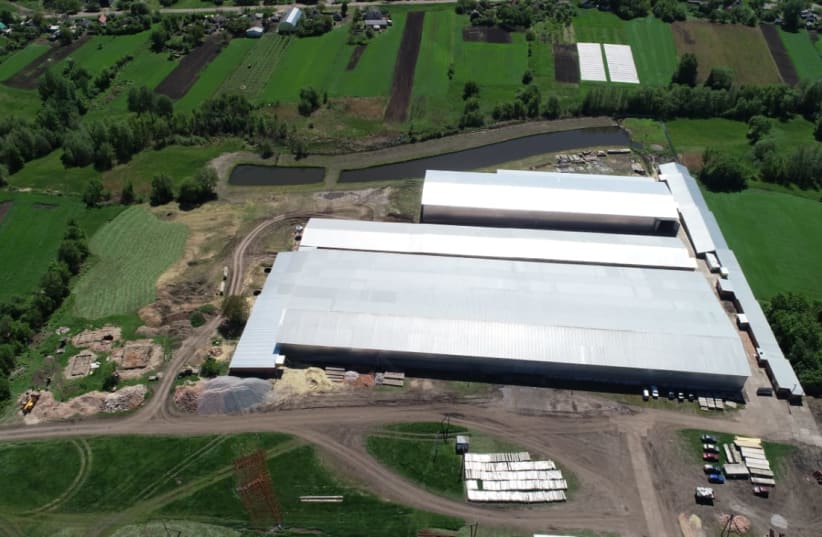Along the Ukrainian-Russian border, many farmers are continuing to harvest their crops despite the inherent dangers of the ongoing war.
“It’s a very dangerous situation because of the mines on the fields and roads. It can be just over here,” Birkiuk Maksym who owns a 3,000-hectare sunflower seed plantation near the village of Rozoshi only a few kilometers from the border with Russians explains.
Maksym knows the dangers directly having already lost one of his 30 permanent workers – a truck driver – to an anti-tank mine in July this year.
“Our worker, one month ago, on the 30th of July, I found out there was a huge explosion. In total 11 anti-tank mines [exploded]. He had no chance, he died immediately, and his body was flown over 200 meters from the car,” he tells us.

Ukraine has signed the 1997 Mine Ban Treaty that comprehensively prohibits all types of victim-activated explosive devices. Russia has not joined the treaty but is bound by the prohibitions and restrictions on mines, booby-traps, and other devices under the United Nations Convention on Conventional Weapons.
There is no credible information on the number of landlines in Ukraine; it has, however, been widely reported that both Russia and Ukraine have extensively used anti-vehicle mines (also called anti-tank mines) in at least seven regions: Donetsk, Chernihiv, Kharkiv, Kyiv, Odesa, Zaporizhzhia, and Sumy – where Maksym’s farm is located.
When did it all start?
This started in 2014 following the Russian annexation of Crimea and the escalation of the conflict in the Donetsk region and has only been exacerbated by the Russian full-blown invasion of the country on February 24 of this year.
The area around Maksym’s farm [in the Sumy Oblast] – which has some of the most fertile fields and climate in Ukraine – was heavily attacked at the start of the conflict. The village of Rozoshi is along the road toward the military town of Ohturka which was a key strategic target for the Russian forces in the first few days of the conflict.
“The Russians attacked the army base in Ohturka on the first few days of the war,” Sergiy Miroskniche, a local from the town explains, “and a Russian vehicle was destroyed by Ukrainian forces [and] it was full of ammunition, which detonated and also destroyed my house, setting it on fire.”
In the initial stages of the conflict, the Ukraine forces managed to repel the attack on Ohturka. However, much of the city’s sewage and water supply network was destroyed and has yet to be fully rebuilt.
In the following weeks, the Ukraine forces then managed to further push the Russian military back towards the border, liberating Maksym’s farm and other villages to the east and along the border.
“At the moment, we can’t plant around 200 hectares at the border; before the war, we could but we have been informed by the Ukrainian military that they need this area for security [patrols] and it also [potentially] has a lot of mines,” the farmer tells us.
Foreign countries, particularly in the Third World, are heavily reliant on Ukraine for staples like sunflower oil, produced on Maksym’s farm; however, the war has put a dent in the ability of Ukrainian farmers to export.
Last August, the Biden Administration said that it would provide $89 million to help Kyiv clear land mines that now litter huge swaths of Ukraine after Russia’s February invasion, according to a senior State Department official.
The money will fund 100 de-mining teams in Ukraine for the next year, according to the official.

Since Russian forces invaded the country six months ago, a large swath of Ukraine has been littered with land mines planted by those forces “in an irresponsible and brutal manner,” the official told reporters. In particular, the official condemned Russia’s use of cluster munitions and butterfly mines, weapons that Moscow also deployed in Afghanistan in the early 1980s and that continue to kill civilians today.
“As Russian forces retreated from northern Ukraine, they had booby traps and improvised explosive devices in food facilities, car trunks, washing machines, doorways, hospital beds, and even the bodies of those killed by the invasion,” the official said, describing how they “deliberately hid explosives in toys and shiny objects that attract children’s attention.”
The government of Ukraine estimates that as many as 62,000 square miles of Ukrainian land could be “contaminated” by mines, according to Kyiv’s most recent estimate.
The area includes a large chunk of Ukraine’s farmland, the US official said.
A recently negotiated settlement last month, however, allowed the resumption of some of Ukraine's food exports via the southern port of Odesa, under the auspices of the UN and Turkey, however, this is not really helping Maksym.
“I can only sell my corn at $60 per ton. It's sad; before, it was $170,” he explains. "And now I can only really sell to local markets.”
He is also having significant problems due to rising costs: Hiring workers are expensive (and dangerous) and the costs of basic raw materials such as fertilizer and energy have also doubled since the start of the war.
“At the moment, we are really in survival mode. In the future, maybe in September or October, we might sell some for a low price in Odesa but now it just is not economical for us to do so.”

